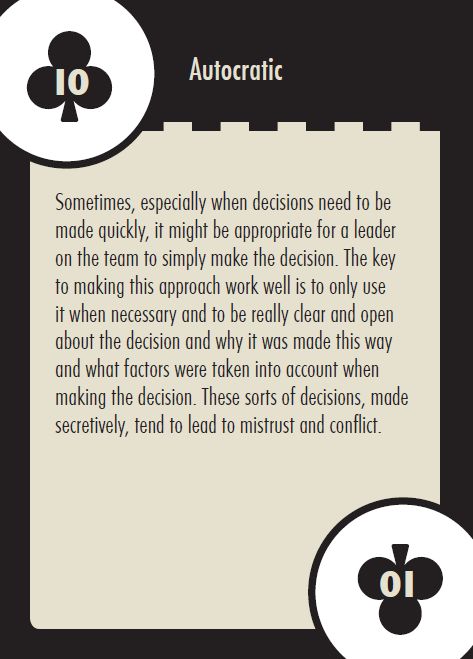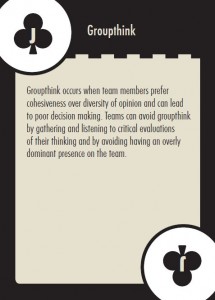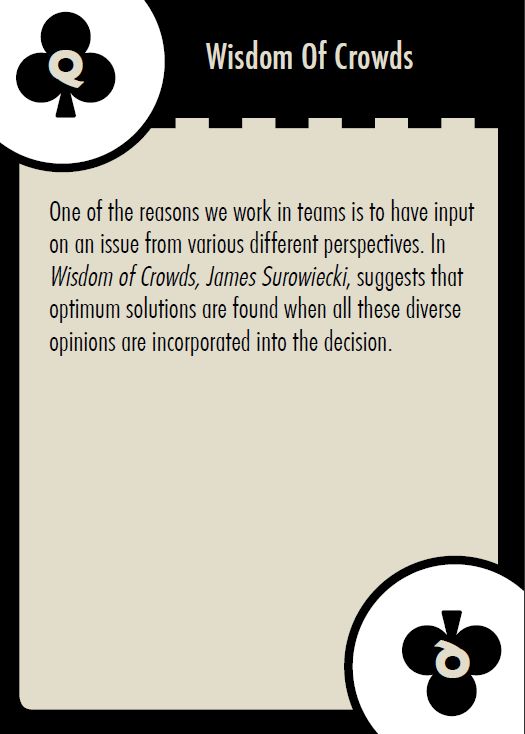Does your team have the same conversation over and over and/or not follow through on your decisions? Clearly documenting decisions is one way to avoid this. It’s also useful to mention the decision making strategy employed and who was involved in the decision as well as the outcome of the decision. This blog is based on the three of clubs from our Teamwork Explorer cards and iPhone app.
It’s Time for the Adult to Take Over
“I feel like I’m playing in the sandbox with a bunch of misbehaving kids,” lamented Pat, a very successful CEO of a large company. She was a collaborative leader who involved her executives in decision making, but the team was under stress and acting like a group of little kids in the sandbox.
“Perhaps it’s time for the adult to take over,” I suggested which led to a fascinating conversation about the challenges of being a collaborative leader. I had learned this from IDEO, a very successful design company, whose innovation teams are very collaborative, creative and emergent, and also, at the right times, directed by a few of the “self appointed adults” to complete certain tasks to ensure that they don’t spin off into complete chaos.
You know it’s time for the team leader to be the “adult” and take over when:
- Problem solving processes have run their course and you need to move forward. Some teams can get into “ideaphoria” and resist closure because they are not confident about their ability to deliver. The team leader needs to force closure on the team and help the team with its confidence.
- Timelines are critical and short and there is no time for collaboration. The team leader needs to provide the plan and delegate to get the task done.
- Some (or all) team members do not have the skills. The team leader needs to provide direction and suggestions about how to tackle the problem at hand.
- The team is not functioning well as a team. Once again, the team leader needs to provide direction and suggestions or delegation of tasks to get things done.
- If a team is under extreme stress, the leader needs to help the team take a time out, regroup and get back on track.
- If there has been a major emergency or catastrophe that is likely to cause chaos, confusion, or strong emotions, the leader needs to step in and provide stability and direction for the team.
The key to switching between a collaborative and autocratic style is to let your team members know, ideally before, but certainly at the time, why you are using this particular style. If you don’t, you risk breaking trust with team members. If you are on a team where there is no formal leader, have the conversation about who the “adults” will be in the above situations. It will save your team time and heartache.
What style do you use? Are there times when you’ve used a more autocratic style?
This blog is based on the 10 of Clubs, Autocratic, taken from our Teamwork Explorer. Written by Tammy.

What your Team can Learn from JFK
Amid much controversy, The Kennedys is now showing in Canada (well, at least the 2 episodes that I have taped on my PVR!). The reviews have certainly been mixed but I simply cannot help myself. I love a good story and I have been especially intrigued by the Kennedys for many years. I watched the episode highlighting the Bay of Pigs on the weekend and was reminded of the work of Irving Janis on groupthink. Groupthink is a phenomena he coined which describes the tendency of some really cohesive teams to ignore alternative pespectives and courses of action. The symptoms of groupthink according to Janis are:
-
- Illusion of invulnerability – the team thinks that they can do no wrong or harm.
- Collective rationalization – the team discounts alternative views and doesn’t challenge their own assumptions.
- Belief in inherent morality – the team thinks they are the moral compass for everyone.
- Stereotyped views of out-groups – people or groups with different views are made to be the “enemy”.
- Direct pressure on dissenters – anyone who disagrees with the team is greatly pressured to conform.
- Self-censorship – people do not express contradictory views.
- Illusion of unanimity – silence is assumed to be unanimity.
- Self-appointed ‘mindguards’ — stronger team members will filter out contradictory views.
I am especially interested in groupthink because I have been guilty of it myself and relate to the above 8 symptoms. As someone who values harmony and cohesiveness, I need to work hard at hearing alternative perspectives. I work on many faculty teams to deliver intensive leadership development programs and in our desire to deliver a high quality learning experience, I think we sometimes filter out feedback that challenges our particular philosophy of leadership.
Some remedies for groupthink include:
-
- The team leaders being aware of their power over the group and holding back on their preferences until other team members have spoken.
- The team assigning the role of critical evaluator or devil’s advocate to team members and/or bringing in expert, outside opinions to challenge the team.
- The team setting aside regular time to surface and assess their assumptions, as well as surface and consider alternative perspectives.
While the Bay of Pigs was devastating, some have suggested Kennedy learned from that mistake and avoided groupthink during the Cuban Missile Crisis by inviting outside experts to share their viewpoints, dividing the group up into various sub-groups, and being deliberately absent from the meetings, so as to allow others open expression of viewpoints.
Has your team had a Bay of Pigs disaster? Which remedies might work for your team?
This blog is based on the Jack of Clubs, Groupthink, taken from our Teamwork Explorer.

Written by Tammy
Wisdom of Crowds
Today’s Teamwork Explorer Tip is the Queen of Clubs (decision making) – Wisdom of Crowds. (Need to know more about our approach to teamwork?) See our Teamwork Explorer blog post.)

Queen of Clubs – Wisdom of Crowds
One of the reasons we work in teams is to have input on an issue from various different perspectives. In Wisdom of Crowds, James Surowiecki, suggests that optimum solutions are found when all these diverse opinions are incorporated into the decision.
How do you ensure that you hear all voices on the team, even the unpopular ones? Obviously this is very much dependent on the nature of the team, and there’s no one right answer. However, my work with teams suggests that some of the best ways to elicit diverse opinions would include setting clear ground rules that encourage the non-judgmental sharing of ideas. You also have to ask the right questions. Sometimes team members can have valuable input, but fail to share it because they don’t think it’s been asked for, or that it will add value. “Does anyone have anything else to share (no matter how crazy it may sound) regarding this issue?” or something similar is a great question to ask before moving to decision making.
Of course, the next big challenge, once all the diverse opinions are shared, is to incorporate them into a decision. The Jelly Beans in the Jar example is very straightforward. Fill a glass jar with jelly beans and ask people to guess how many there are. Then calculate the mean of the answers. I’ve tested this with several groups and the mean is almost always the best answer in the room.
It gets more complex of course when the problem at hand is something more realistic that the team really needs to move forward on. An approach I find useful when opinions are so diverse (perhaps even contradictory) that they can’t be incorporated into a single solution, is scrap the idea that there is one best solution. Once teams start looking for multiple, good, potential solutions, rather than the one best solution, they can move forward with testing prototypes rather getting stuck in what is often called “analysis paralysis”.
Finally a word of caution. Not all decisions lend themselves to a Wisdom of Crowds approach. The decision about which decision making approach is the most appropriate, is of course, the most important decision!
Curious about the rest of the tips and want to know all about them now? Find out more!
Posted by Dave

